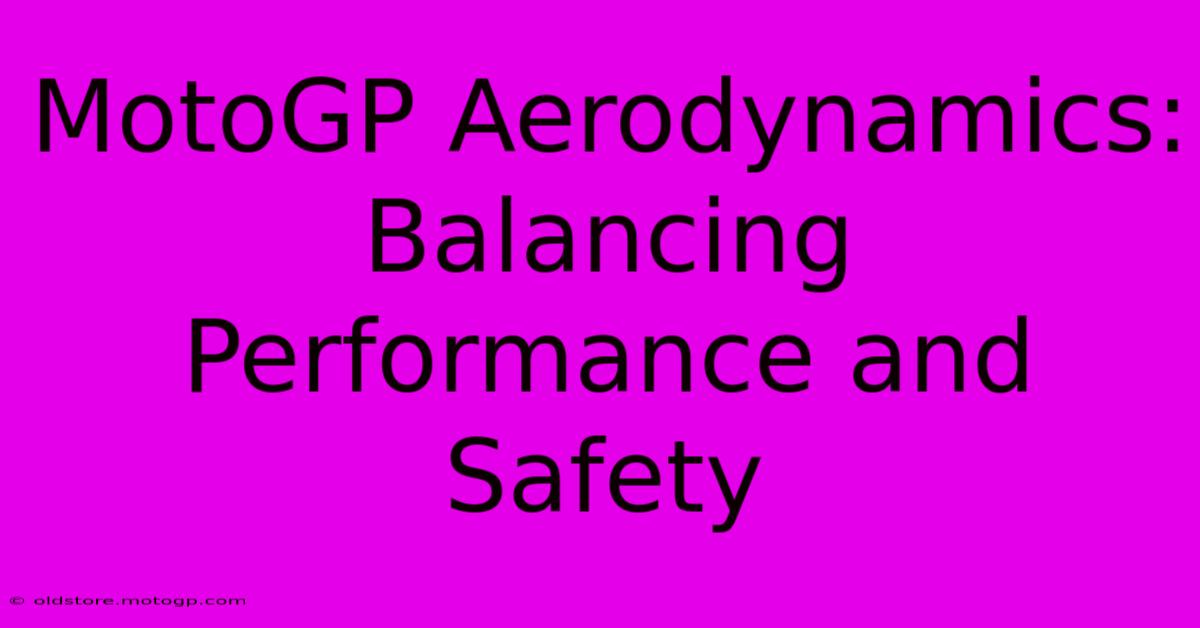MotoGP Aerodynamics: Balancing Performance And Safety

Table of Contents
MotoGP Aerodynamics: Balancing Performance and Safety
MotoGP racing is a relentless pursuit of speed and precision, where even the smallest aerodynamic advantage can mean the difference between victory and defeat. This article delves into the crucial role aerodynamics plays in MotoGP, exploring how teams strive to balance performance gains with rider safety. We'll examine the complex interplay of wings, fairings, and other aerodynamic devices, and how regulations attempt to control their impact.
The Science of Speed: Aerodynamic Downforce in MotoGP
Aerodynamics in MotoGP isn't just about reducing drag; it's primarily about generating downforce. This downward force pushes the motorcycle and rider firmly onto the track, allowing for higher cornering speeds and improved stability at high velocities. Think of it as a giant invisible hand pressing the bike to the asphalt.
Wings, Winglets, and More: Aerodynamic Devices
The most visible aspect of MotoGP aerodynamics is the array of wings and winglets attached to the fairings. These aren't simply for show; they're meticulously designed to manipulate airflow, creating the crucial downforce. Their precise placement, angle, and shape are constantly refined through computational fluid dynamics (CFD) simulations and extensive wind tunnel testing.
- Front wings: These often generate a significant portion of the downforce, improving front-end stability during braking and corner entry.
- Rear wings: These manage airflow around the rear wheel and contribute to overall stability and traction. Their design significantly impacts rear-wheel lift, a major factor in high-speed stability.
- Underbody aerodynamics: While less visible, the design of the underbody and fairings is crucial. Smooth airflow underneath the bike reduces drag and further enhances stability.
The Safety Factor: Managing the Risks of High Downforce
While increased downforce translates to improved performance, it also presents significant safety challenges. Higher downforce can lead to:
- Increased braking distances: While cornering speeds increase, the added downforce can make braking more challenging and increase stopping distances.
- High-speed instability: If the downforce isn't perfectly balanced, high-speed instability can occur, leading to crashes.
- Increased risk of injuries in crashes: The increased speeds and downforce can amplify the impact forces in a crash, potentially increasing rider injuries.
MotoGP Regulations: Balancing Performance and Safety
The governing body, Dorna Sports, implements regulations to mitigate these safety risks while still allowing teams to innovate. These regulations often focus on:
- Wing dimensions and positioning: Strict limits are placed on the size, shape, and placement of wings and winglets to prevent excessive downforce.
- Aerodynamic testing restrictions: Rules limit the amount of wind tunnel and CFD testing teams can conduct, aiming to create a more level playing field and prevent an excessive arms race in aerodynamic development.
- Trackside monitoring: Strict monitoring systems ensure teams comply with the regulations, utilizing trackside sensors and data analysis to check aerodynamic performance.
The Future of MotoGP Aerodynamics
The ongoing evolution of MotoGP aerodynamics is a fascinating blend of engineering prowess and safety concerns. Future developments will likely involve:
- More sophisticated CFD simulations and wind tunnel testing: Allowing for more refined designs and better performance optimization.
- Further refinement of regulations: Dorna will continue to adapt regulations to find the optimal balance between performance and safety.
- Innovative aerodynamic solutions: Teams will constantly seek novel ways to generate downforce, possibly exploring unconventional approaches.
In conclusion, MotoGP aerodynamics are a crucial aspect of the sport, representing a fine line between pushing the boundaries of performance and ensuring rider safety. The constant interplay of innovation, regulation, and safety considerations creates a dynamic and captivating element of this high-stakes motorsport. The future will undoubtedly see further advancements in this complex and crucial area of MotoGP technology.

Thank you for visiting our website wich cover about MotoGP Aerodynamics: Balancing Performance And Safety. We hope the information provided has been useful to you. Feel free to contact us if you have any questions or need further assistance. See you next time and dont miss to bookmark.
Featured Posts
-
Gear Up With The Latest Cota Merch
Feb 20, 2025
-
F1 Vs Moto Gp The Ultimate Test Of Skill
Feb 20, 2025
-
F1 Concert Where Passion Meets Innovation
Feb 20, 2025
-
Live Your Best Life In Cota Lot A
Feb 20, 2025
-
Moto2 Standings 2025 A Thrilling Championship Battle
Feb 20, 2025
